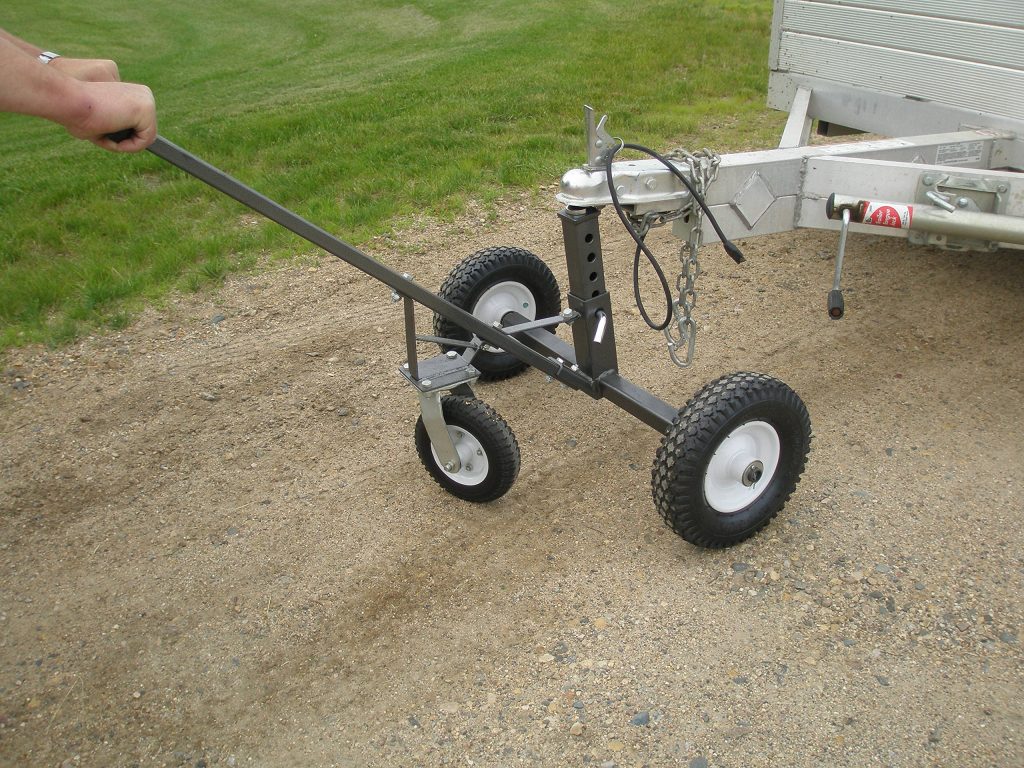A trailer dolly, also known as a trailer mover or trailer jack, is a device used to move trailers easily and efficiently. It’s typically used for small to medium-sized trailers that need to be maneuvered in tight spaces or positioned accurately.
A trailer dolly usually consists of a sturdy frame with wheels, a hitch or coupling mechanism to attach to the trailer, and a handle for manual control. The wheels can vary in size and design, offering different levels of mobility and stability based on the terrain and trailer weight.
The purpose of a trailer dolly is to assist in moving trailers without the need for a vehicle to tow them. This can be useful for parking trailers in confined areas, aligning them for hitching to a vehicle, or making minor adjustments during loading or unloading.
There are also motorized or powered trailer dollies available, equipped with an electric motor or other power sources to further ease the task of moving heavy trailers. These motorized versions provide enhanced control and can handle larger trailers or heavier loads.
Overall, a trailer dolly is a valuable tool for individuals or businesses involved in transporting trailers, making trailer handling more convenient and efficient.

Enhancing trailer maneuverability is a key objective in the realm of trailer handling and transportation. This involves employing various strategies and tools to optimize the movement and control of trailers, ultimately improving safety, efficiency, and ease of use.
One effective approach to enhance maneuverability is through the use of trailer dollies. These specialized devices provide additional control and precision when positioning or relocating a trailer. By attaching a dolly to the trailer’s hitch, individuals can easily move it by hand, allowing for smoother navigation in tight spaces or challenging terrains.
Moreover, advancements in technology have led to the development of motorized trailer dollies. These electric or powered devices further enhance maneuverability, particularly for heavier trailers. They offer increased pulling capacity and can handle inclines or slopes, providing a more versatile solution for moving trailers effortlessly.
In summary, enhancing trailer maneuverability is a critical aspect of efficient trailer management, and the utilization of trailer dollies, especially motorized variants, significantly contributes to achieving this objective.
Here are common situations when a tow truck dolly is generally used:
- Disabled or Inoperable Vehicles: Tow dollies are commonly used for vehicles that are disabled, inoperable, or have a flat tire. The dolly allows the tow truck to lift the front or rear wheels off the ground while towing the vehicle.
- Repossessions: Tow dollies are often used for repossessing vehicles. When repossessing a vehicle, a tow dolly can be employed to lift and tow the vehicle without needing to start or operate it.
- Uneven or Limited Space: In situations where the vehicle cannot be easily loaded onto a flatbed tow truck due to limited space or an uneven surface, a tow dolly provides a practical solution. It allows for easy towing in tight or challenging spaces.
- Towing Front-Wheel Drive Vehicles: Tow dollies are commonly used for front-wheel drive vehicles. The dolly lifts the front wheels off the ground, allowing the rear wheels to roll freely while being towed.
- Towing Multiple Vehicles: When a tow truck needs to tow more than one vehicle simultaneously, tow dollies can be used to tow an additional vehicle behind the tow truck, especially when towing a vehicle with a flatbed.
- Short-Distance Towing: Tow dollies are suitable for short-distance towing needs, especially when the destination is nearby and the vehicle’s rear wheels can remain on the ground.
- Lighter Vehicles: Tow dollies are often used for lighter vehicles such as sedans, compact cars, or smaller SUVs. The dolly can safely tow these vehicles without the need for a flatbed tow truck.
